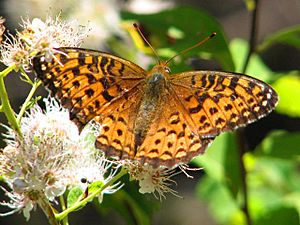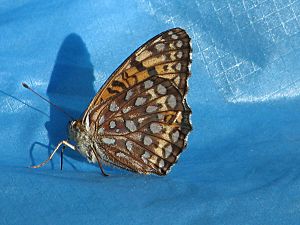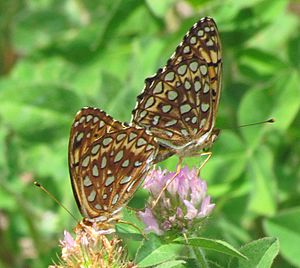Atlantis fritillary facts for kids
Quick facts for kids Atlantis fritillary |
|
|---|---|
 |
|
| Temagami, Ontario | |
 |
|
| View of underwings | |
| Scientific classification |
The Atlantis fritillary (scientific name: Speyeria atlantis) is a beautiful butterfly found in North America. It belongs to the Nymphalidae family, which is a large group of butterflies often called "brush-footed butterflies." This butterfly was first described by William Henry Edwards in 1862.
What it Looks Like
The Atlantis fritillary has a dark orange color on its upper wings. You'll see many rows of black marks and black edges on its wings. The underside of its wings is a lighter brown. It has many shiny, silvery-white spots there. These butterflies have a wingspan that can be anywhere from 50 to 64 millimeters wide. That's about the length of a credit card!
Where it Lives
You can find the Atlantis fritillary across a wide area of North America. They live from the Avalon Peninsula in Newfoundland and Labrador all the way to northern British Columbia. They also live in the northern parts of the United States. Their range goes as far south as Colorado and West Virginia. In the north, they can be found near James Bay. Sadly, this butterfly is listed as endangered in Connecticut.
What it Eats
Young Atlantis fritillaries, called larvae or caterpillars, mostly eat violets. Adult butterflies enjoy nectar from many different flowers. Some of their favorite foods include common milkweed, mint, mountain laurel, crown vetch, burdock, boneset, ox-eye daisy, spiraea, and virgin's bower.
Similar Butterflies
It can sometimes be tricky to tell the Atlantis fritillary apart from other similar butterflies. Here are a few that look a lot like it:
- Aphrodite fritillary (Speyeria aphrodite)
- Great spangled fritillary (Speyeria cybele)
- Northwestern fritillary (Speyeria hesperis)
See Also
- List of butterflies of North America


